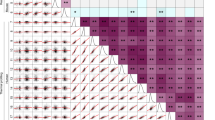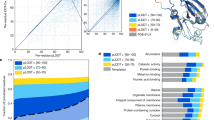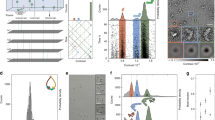Abstract
High-throughput in vitro refolding of proteins that contain disulfide bonds, for which soluble expression is particularly difficult, is severely impeded by the absence of effective methods for detecting their native forms. We demonstrate such a method, which combines mass spectrometry with mild reductions, requires no prior experimentation or knowledge of proteins' physicochemical characteristics, function or activity, and is amenable to automation. These are necessary criteria for structural genomics and proteomics applications.
This is a preview of subscription content, access via your institution
Access options
Subscribe to this journal
Receive 12 print issues and online access
$209.00 per year
only $17.42 per issue
Buy this article
- Purchase on Springer Link
- Instant access to full article PDF
Prices may be subject to local taxes which are calculated during checkout

Similar content being viewed by others
References
Bhattacharya, A., Tejero, R. & Montelione, G.T. Proteins 66, 778–795 (2007).
Fiser, A. & Simon, I. Methods Enzymol. 353, 10–21 (2002).
Song, J.N., Wang, M.L., Li, W.J. & Xu, W.B . Biochem. Biophys. Res. Commun. 318, 142–147 (2004).
Wedemeyer, W.J., Welker, E., Narayan, M. & Scheraga, H.A . Biochemistry 39, 4207–4216 (2000).
Narayan, M., Welker, E., Wedemeyer, W.J. & Scheraga, H.A Acc. Chem. Res. 33, 805–812 (2000).
Tu, B.P. & Weissman, J.S. J. Cell Biol. 164, 341–346 (2004).
Wedemeyer, W.J., Xu, X., Welker, E. & Scheraga, H.A. Biochemistry 41, 1483–1491 (2002).
Rothwarf, D.M., Li, Y.J. & Scheraga, H.A. Biochemistry 37, 3760–3766 (1998).
Ruoppolo, M. et al. Biochemistry 39, 12033–12042 (2000).
Welker, E., Hathaway, L. & Scheraga, H.A. J. Am. Chem. Soc. 126, 3720–3721 (2004).
Arolas, J.L., Aviles, F.X., Chang, J.Y. & Ventura, S. Trends Biochem. Sci. 31, 292–301 (2006).
van den Berg, B. et al. EMBO J. 18, 4794–4803 (1999).
Ge, Y. et al. J. Am. Chem. Soc. 124, 672–678 (2002).
Han, X., Jin, M., Breuker, K. & McLafferty, F.W. Science 314, 109–112 (2006).
Welker, E., Narayan, M., Wedemeyer, W.J. & Scheraga, H.A. Proc. Natl. Acad. Sci. USA 98, 2312–2316 (2001).
Acknowledgements
This research was supported by National Institutes of Health grants GM-24893 (to H.A.S.) and GM-16609 (to F.W.M.), by NORT(DNT), Hungary, OTKA-NF61431 (to E.W.), and by UTEP startup money (to M.N.). E.W. is a Howard Hughes Medical Institute international scholar and an EMBO-HHMI start up grantee.
Author information
Authors and Affiliations
Corresponding authors
Supplementary information
Supplementary Text and Figures
Supplementary Tables 1,2, Notes, Methods (PDF 189 kb)
Rights and permissions
About this article
Cite this article
Narayan, M., Welker, E., Zhai, H. et al. Detecting native folds in mixtures of proteins that contain disulfide bonds. Nat Biotechnol 26, 427–429 (2008). https://doi.org/10.1038/nbt1380
Received:
Accepted:
Published:
Issue Date:
DOI: https://doi.org/10.1038/nbt1380
This article is cited by
-
Fred W. McLafferty: The Man Who Drove a Different Kind of Flying Machine
The Protein Journal (2022)



